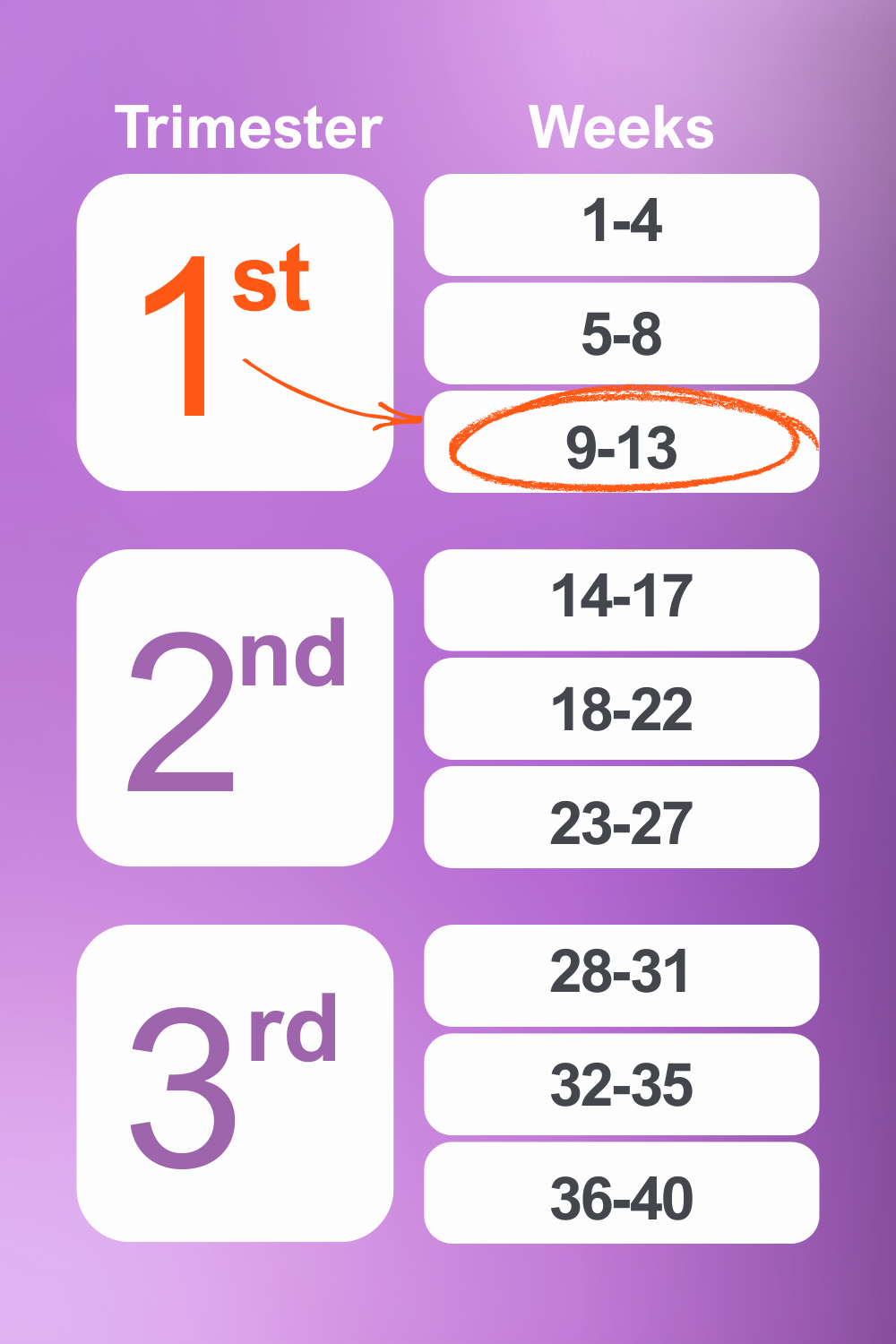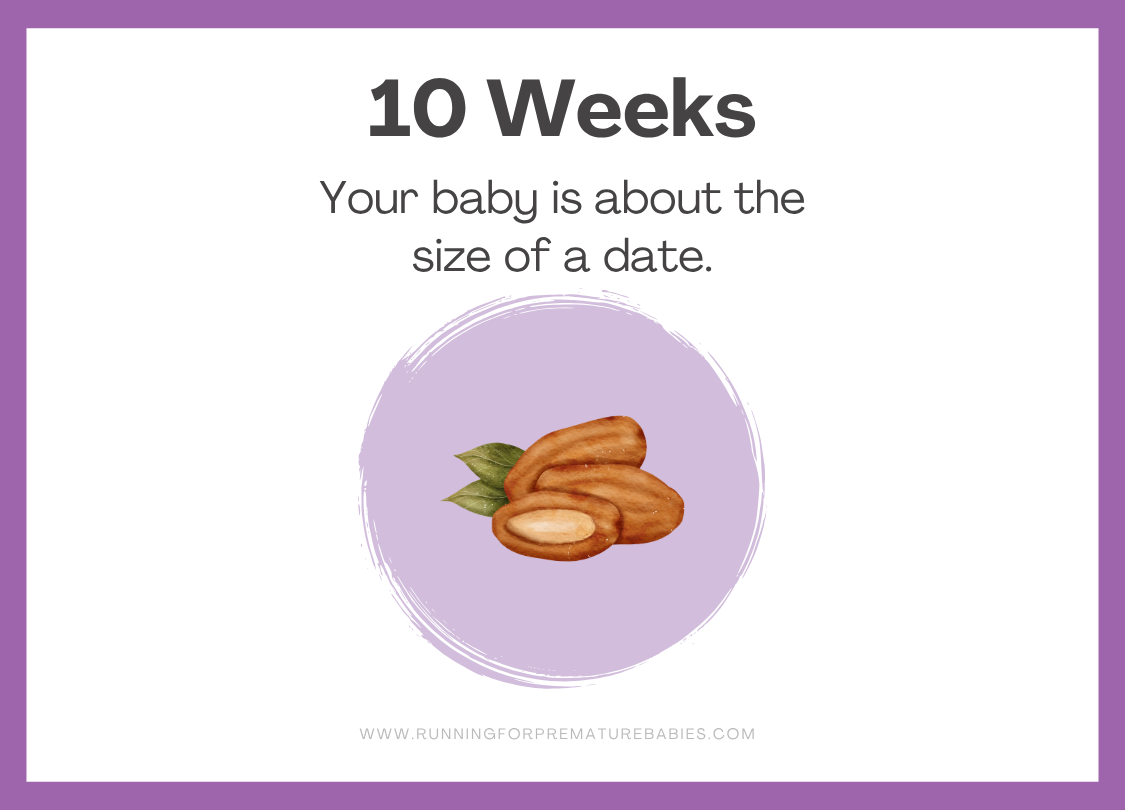Key Milestone Weeks in Pregnancy
First Trimester

Summary:
At 10 weeks pregnant, your baby is now officially a foetus and developing rapidly - about the size of a date, with fingers, toes, elbows, and knees forming, and a heartbeat with four chambers. Internally, sex organs are forming, though they’re not visible yet. You may still experience nausea, fatigue, and mood swings as your hormones peak and the placenta takes over nourishing your baby. Visible veins, mild bloating, or a slight bump may appear. Routine tests like Non-Invasive Prenatal Testing (NIPT) and first trimester screening are typically offered now. While every pregnancy is different, many begin to notice symptom relief as they near the second trimester.
At 10 weeks pregnant, your body is working hard as your hormones continue to rise, which may cause nausea, fatigue, and mood swings. These hormones help maintain the uterine lining and support the placenta, which is now taking over from the yolk sac. Your uterus is about the size of a grapefruit, and you might notice a small bump starting to show. Visible veins may appear on your chest and abdomen due to increased blood volume. You may experience constipation, bloating, or heartburn as your digestive system slows down and vaginal discharge may increase which is normal and helps prevent infections. It’s common to feel emotional or overwhelmed. Hormones, fatigue, and the reality of pregnancy can all play a part. At this time your metabolic rate is increasing to support your baby’s growth, and you might notice increased appetite or changes in your skin, like acne or a pregnancy "glow" due to increased oil production and circulation.You’re nearing the end of the first trimester, so relief from symptoms like morning sickness may be just around the corner.

At 10 weeks pregnant, your baby is officially in the foetal stage and growing fast. Your baby is about 3.5 cm long from head to bottom and weighs around 8 grams and is roughly the size of a date. The heart now has four chambers and is beating strongly. Bones are forming, and your baby is developing elbows, knees, wrists, and ankles, although they are still soft and flexible. The webbing between fingers and toes has disappeared, and your baby can almost touch their face. Fingernails may also start to appear. Internal sex organs are formed, but it is too early to see external differences on an ultrasound. By week 10, tooth buds are forming under the gums, and the diaphragm begins developing. Though too small to feel, the foetus is starting to move spontaneously. The tail has completely disappeared, and your baby is starting to look more recognisably human.1
See FAQs Below
Get Involved
Run with us
Donate
Join the Premmie Marathon Challenge
FAQs
Is it normal to still have morning sickness at 10 weeks pregnant?
Yes, it’s completely normal to still have morning sickness at 10 weeks pregnant as the symptom typically occurs during the first trimester, between weeks 6-14. For many people, this is when symptoms like nausea and vomiting are at their peak. While it’s called “morning” sickness, it can happen at any time of day. It is unusual to experience morning sickness for the first time after week 10, so if symptoms begin suddenly at this stage, it is a good idea to check in with your doctor to rule out other causes. If your symptoms are severe or you are struggling to keep food or fluids down, it might be a sign of a more serious condition called hyperemesis gravidarum, which requires medical attention.
What tests are done at 10 weeks pregnant?
At around 10 weeks pregnant, you might be offered a few important tests as part of your routine antenatal care. These check on both your health and your baby’s development:
- Non-Invasive Prenatal Testing (NIPT): A blood test that screens for chromosomal conditions like Down Syndrome. It can also reveal your baby’s sex if you wish to know.
- First Trimester Combined Screening: This includes a blood test (usually done between 10–12 weeks) and an ultrasound (typically between 11–13 weeks) to assess the risk of chromosomal abnormalities.
- Routine Blood Tests: These check your blood group, iron levels, immunity to infections like rubella, and screen for conditions such as HIV, hepatitis B and C, and syphilis.
- Urine Test: To detect urinary tract infections or other abnormalities.
- Mental Health and Wellbeing Screening: Some providers may also check in on your emotional health and social support during this time.
These tests are optional, and your doctor or midwife will guide you through what is recommended based on your personal health and pregnancy history.
Should I have a baby bump at 10 weeks pregnant?
At 10 weeks pregnant, it is normal not to have a visible baby bump yet, especially if this is your first pregnancy. While your uterus is growing and your baby is developing rapidly, most people don’t show a noticeable bump until around 12-16 weeks. At 10 weeks, your uterus is still tucked within your pelvis, so any changes in your belly are usually subtle, like slight bloating or a feeling of fullness. You might notice:
- A slightly rounder lower abdomen, especially by the end of the day.
- Bloating due to hormonal changes.
- Tightness in your clothes, even if there’s no visible bump yet.
If this is your second or later pregnancy, you might start to show a little earlier, sometimes around 10 weeks, because your abdominal muscles have stretched before.
What foods should I focus on at 10 weeks pregnant?
A balanced diet including lean proteins, iron-rich foods, whole grains, leafy greens, and vitamin D sources is essential. Folic acid remains important, and staying hydrated helps ease constipation.
Can I still exercise at 10 weeks pregnant?
Yes, gentle, regular exercise like walking, prenatal yoga, and swimming is safe for most people unless advised otherwise. Avoid high-impact sports or activities that risk abdominal trauma.
Can I see or hear the heartbeat at 10 weeks?
You may be able to hear the heartbeat with a doppler at a GP visit around this time, although success varies. An ultrasound may clearly show the heartbeat by now.
Early Pregnancy Care Principles
The latest guidelines and care principles for early pregnancy include:
- Early antenatal visits: Are encouraged to confirm the pregnancy, estimate gestational age, and begin discussions about lifestyle, nutrition, and mental health.
- Folic acid supplementation: Strongly recommended to reduce the risk of neural tube defects, which are forming around week 5 of pregnancy.
- Screening for risk factors: This includes assessing for miscarriage risk, preeclampsia, and mental health concerns like anxiety or depression.
- Lifestyle guidance: Advice on avoiding alcohol, tobacco, and certain medications is emphasised early on, along with support for healthy eating and physical activity.
- Cultural and individualised care: The guidelines stress the importance of woman-centred care, especially for Aboriginal and Torres Strait Islander women, migrants, and those with complex needs.
Related reading:
First Trimester
What to expect when you're 3-4 weeks pregnant
What to expect when you're 5 weeks pregnant
What to expect when you're 6-9 weeks pregnant
What to expect when you're 10 weeks pregnant
What to expect when you're 12 weeks pregnant
What to exprect when you're 14 weeks pregnant
Second Trimester
What to expect when you're 18 weeks pregnant
What to expect when you're 20 weeks pregnant
What to expect when you're 22-23 weeks pregnant
What to expect when you're 24 weeks pregnant
What to expect when you're 26-27 weeks pregnant
Third Trimester
What to expect when you're 28 weeks pregnant
What to expect when you're 29 weeks pregnant
What to expect when you're 30 weeks pregnant
What to expect when you're 32-33 weeks pregnant
What to expect when you're 34 weeks pregnant
What to expect when you're 36 weeks pregnant
What to expect when you're 37 weeks pregnant
What to expect when you're 38-40 weeks pregnant
If you would like to run with us, either in memory of a precious baby, to celebrate new life, or simply to add purpose to your fitness journey, click here to find out how you can help give babies a better chance of survival.
Pregnancy, Birth and Baby. (n.d.). Pregnancy, birth, and baby. Australian Government. Retrieved 20th June 2025 https://www.pregnancybirthbaby.org.au/
Sydney Children's Hospitals Network. (n.d.). Tests and scans during pregnancy. Kids Health Hub. Retrieved 20th June 2025 https://www.schn.health.nsw.gov.au/kids-health-hub/pregnancy-and-your-baby/tests-and-scans-during-pregnancy
Australian Living Evidence Collaboration. (n.d.). LEAPP – Living Evidence for Australian Pregnancy and Postnatal Care. Living Evidence. Retrieved 20th June 2025 https://livingevidence.org.au/living-guidelines/leapp/


